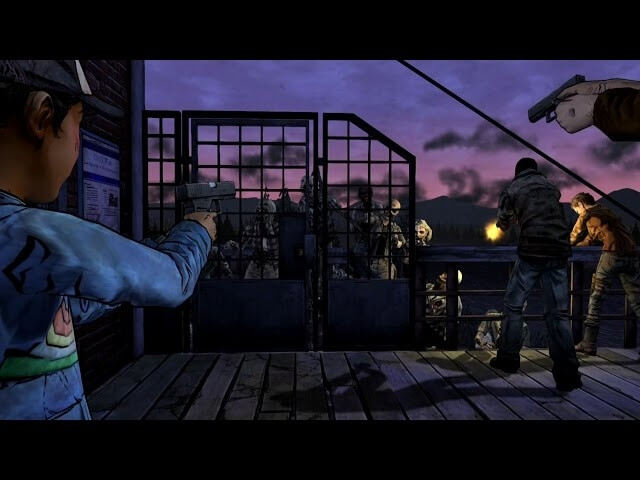The Walking Dead: Season Two found the best place for a group breakdown

This article discusses specific plot details from Telltale Games’ The Walking Dead: Season Two.
The Walking Dead: Season Two (2013-2014)—Amid The Ruins
Zombies are the ultimate social out-group. From Romero to Kirkland, boilerplate zombie-apocalypse stories tend to concern a group of heroic survivors holding fast against the unthinking masses of the undead. The survivors may squabble, but the real threats always come from outside. Even when the true villains are other humans, their otherness implicitly aligns them more with the zombies. It’s an “us versus them” setup exaggerated to the point where everybody outside the main group is a literal monster that is only superficially human. This has been the way for The Walking Dead’s printed and televised incarnations, in which Rick Grimes’ pseudo-family is constantly changing but reliably loyal to him and each other.
The first season of Telltale’s take on The Walking Dead adheres to this same dynamic; the second season pointedly does not. In Season One, main character Lee Everett built a mostly loyal group around himself from scratch, and the series’ fiercest antagonists were envious or psychotic outsiders. With Season Two, the calls started coming from inside the house. The suggestion that group infighting is potentially more destructive than exterior threats is practically uncharted territory for any incarnation of The Walking Dead, so Telltale made sure to give the idea the space it needed to thrive as an overarching theme for the season. Amid The Ruins, the fourth episode of Season Two, is dedicated entirely to exploring this theme, and it chooses the perfect setting for its meditation on infighting.
Season Two begins by making a clean break from the characters, story baggage, and themes of Season One. Main character Clementine is immediately separated from the only other known survivors of the previous season’s events before stumbling upon a new group that—given how trustworthy strangers tend to be in this world—is understandably nervous about her presence. After earning their trust, Clem learns that they’re on the run from William Carver, their tyrannical ex-leader and the first character of the season to represent a threat from within a group. During the team’s migration, they come across Kenny, a character from Season One who was believed dead, but that’s not the only reunion in store. Carver captures the group at the end of the second episode, and they spend the third as his prisoners before finally killing him and escaping.
Their escape from Carver’s hardware-store-turned-impenetrable-fortress leads what’s left of the group to Parker’s Run, a Civil War battlefield memorial and lightly fictionalized facsimile of Parker’s Crossroads in Tennessee. This is where Kenny—already constantly on edge and now reeling from the death of his girlfriend—begins his transformation from well-meaning hothead to full-blown antagonist. After personally killing Carver at the end of the last episode, Kenny slowly moves into the void he left behind—that of a brutish, self-elected ruler who terrorizes the people he insists he’s leading. Clementine’s group may have escaped one despot, but Carver’s spirit has followed them and transplanted itself into a new host. Surrounded by monuments memorializing the ultimate act of infighting, Clem’s team begins to destroy itself from within once again.
The setting of Parker’s Run, with its brother-against-brother history, externalizes this chief conflict of Season Two. It renders the character drama as a physical space Clementine can explore, in the same way that she’s expected to navigate the group’s thorny interpersonal issues. Not coincidentally, the group’s first course of action once they’ve all arrived there is to split up, making literal the distance between them and maximizing the legwork Clem has to put in to keep them from each other’s throats. The Civil War memorial setting also evokes Season One protagonist Lee, who was a history professor before the apocalypse—Clem even mentions him as she observes some of the museum’s artifacts. Lee taught her the de-escalation skills she’s now relying on as the group’s peacekeeper, and by physically placing her in his world, Season Two underscores how similar to her old guardian she’s become.
Clem’s new group does eventually reconvene, but it takes an onslaught of undead to bring them to the point that they can stomach each other’s company again. The team makes its stand on an observation deck, and Parker’s Run becomes a battlefield again for the first time in 150 years. Here, just before beginning a fight for their lives, the group discovers that two of its members, Luke and Jane, have started a physical relationship. Hypothetically, it should be a good thing—two group members coming together (so to speak) at a time when the team is most in danger of being torn apart, figuratively and literally. Kenny, naturally, doesn’t see it that way, and even with the group’s lives on the line, wastes valuable time laying into his teammates instead of working with them. It’s around this time that the structure, like the group, collapses.
At the end of Amid The Ruins, what remains of Clem’s group leaves Parker’s Run and heads north. What’s ahead of them is more of the usual Walking Dead locales: abandoned businesses, decrepit homes, lifeless wildernesses, all manner of subtext-free settings sourced from the Beginner’s Guide To Post-Apocalypse Fiction. The in-group conflict at the heart of the season still continues hurtling toward its climax, but the story never visits another location as ripe for exploring it. The spirit of Parker’s Run continues to hang over the group, foreshadowing its eventual self-destruction, right up to the explosion of brutality that closes the season. The final moments of Season Two are hateful, vicious, and totally absent of the undead—just Kenny and Jane, two members of the same team, in a brawl that will end one of their lives. This is one of the only times that The Walking Dead wasn’t about “us versus them” but “us versus ourselves”—and, unavoidably, we lost.